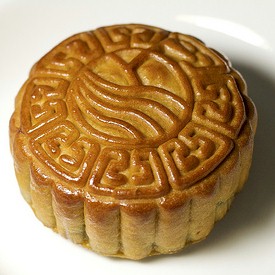Let's have a Mooncake!
Traditional styles
Fillings
Many types of fillings can be found in traditional mooncakes according to the region's culture:
Lotus seed paste (lian rong): Considered by some to be the original and most luxurious mooncake filling, lotus paste filling is found in all types of mooncakes. Due to the high price of lotus paste, white kidney bean paste is sometimes used as a filler.
Sweet bean paste (dou sha): A number of pastes are common fillings found in Chinese desserts. Although red bean paste, made from azuki beans, is the most common worldwide, there are regional and original preferences for bean paste made from mung beans, as well as black beans, known throughout history.
Jujube paste (zao ni): A sweet paste is made from the ripe fruits of the jujube (date) plant. The paste is dark red in color, a little fruity/smoky in flavor, and slightly sour in taste. Depending on the quality of the paste, jujube paste may be confused with red bean paste, which is sometimes used as a filler.
Five kernels (wu ren): A filling consisting of 5 types of nuts and seeds, coarsely chopped, is held together with maltose syrup. Recipes differ from region to region, but commonly used nuts and seeds include: walnuts, pumpkin seeds, watermelon seeds, peanuts, sesame seeds, or almonds. In addition, the mixture will usually contain candied winter melon, jinhua ham, or pieces of rock sugar as additional flavoring.
Sweet bean paste (dou sha): A number of pastes are common fillings found in Chinese desserts. Although red bean paste, made from azuki beans, is the most common worldwide, there are regional and original preferences for bean paste made from mung beans, as well as black beans, known throughout history.
Jujube paste (zao ni): A sweet paste is made from the ripe fruits of the jujube (date) plant. The paste is dark red in color, a little fruity/smoky in flavor, and slightly sour in taste. Depending on the quality of the paste, jujube paste may be confused with red bean paste, which is sometimes used as a filler.
Five kernels (wu ren): A filling consisting of 5 types of nuts and seeds, coarsely chopped, is held together with maltose syrup. Recipes differ from region to region, but commonly used nuts and seeds include: walnuts, pumpkin seeds, watermelon seeds, peanuts, sesame seeds, or almonds. In addition, the mixture will usually contain candied winter melon, jinhua ham, or pieces of rock sugar as additional flavoring.



Crusts
Traditional mooncakes vary widely depending on the region where they are produced. Most regions produce them with many types of fillings, but with only one type of crust. Although vegetarian mooncakes may use vegetable oil, many mooncakes use lard in their recipes.
Three types of mooncake crust are used in Chinese cuisine:
Chewy: This crust has a reddish-brown tone and glossy sheen. It is the most common type of crust used on Cantonese-style mooncakes. It is also the most commonly seen type of mooncake in North America and many Western countries. Chewy mooncake crusts are made using a combination of thick sugar syrup, lye water (sodium carbonate), flour, and oil, thus giving this crust its rich taste and a chewy yet tender texture. Chewiness can be increased further by adding maltose syrup to the mixture.
Flaky: Flaky crusts are most indicative of Suzhou- and Taiwan-style mooncakes. The dough is made by rolling together alternating layers of oily dough and flour that has been stir-fried in oil. This crust has a texture similar to puff pastry.
Tender: Mooncakes from certain provinces of China are often made to be tender rather than flaky or chewy. The texture of this type of mooncake crust is similar to the shortcrust pastry used in Western pie crusts or tart shells. Tender crusts are made mainly of a homogenous mix of sugar, oil, flour, and water. This type of crust is also commonly used in other type of Chinese pastries, such as the egg tart.
The dough is also baked into fish or piglet shapes (Cantonese: jue zai bang; "piglet biscuits") and sold at bakeries as a chewy snack. They often come individually packaged in small plastic baskets, to symbolize fish being caught or piglets being bound for sale.
Flaky: Flaky crusts are most indicative of Suzhou- and Taiwan-style mooncakes. The dough is made by rolling together alternating layers of oily dough and flour that has been stir-fried in oil. This crust has a texture similar to puff pastry.
Tender: Mooncakes from certain provinces of China are often made to be tender rather than flaky or chewy. The texture of this type of mooncake crust is similar to the shortcrust pastry used in Western pie crusts or tart shells. Tender crusts are made mainly of a homogenous mix of sugar, oil, flour, and water. This type of crust is also commonly used in other type of Chinese pastries, such as the egg tart.